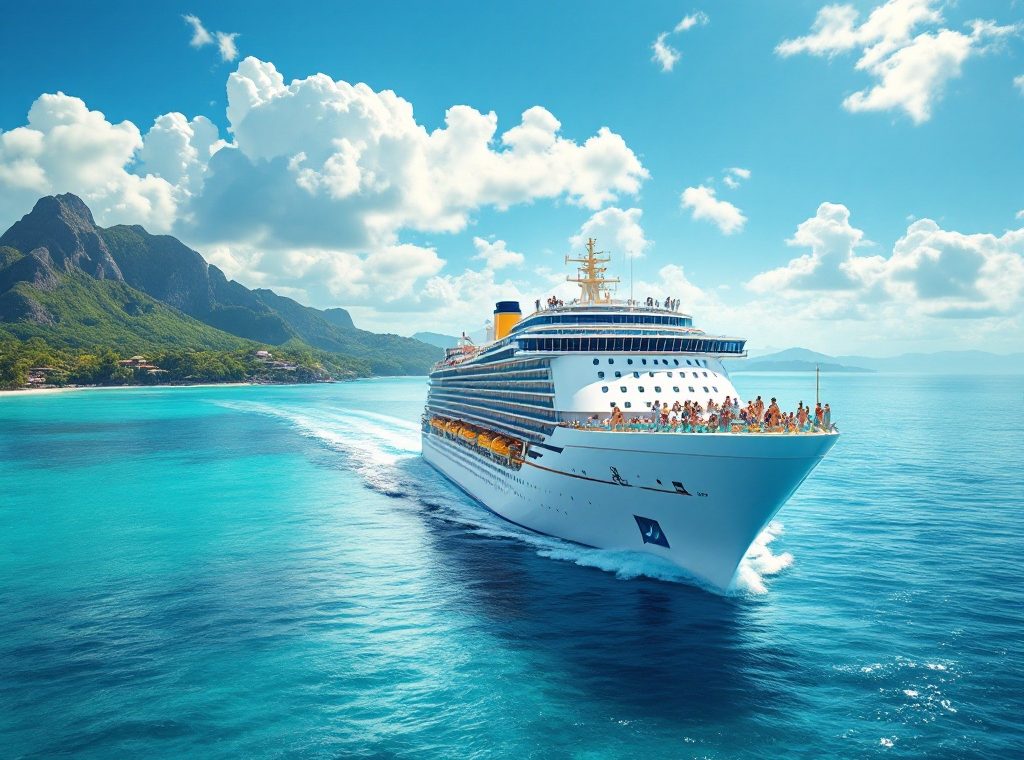What You Must Know before Your First Travel by Sea
Dream of exploring exotic destinations and enjoying unparalleled onboard entertainment? Cruising offers the perfect blend of adventure and relaxation, and planning your first voyage is easier than you think! This comprehensive guide covers everything from choosing the right cruise line and cabin to packing essentials and understanding embarkation day procedures. Discover insider tips for managing your onboard spending, staying healthy at sea, and making the most of your first cruise experience. Set sail for an unforgettable journey – dive in and start planning your dream cruise today!
Important information

- Research different cruise lines, comparing itineraries, onboard amenities, and passenger reviews to find the best fit.
- Plan your budget carefully, considering both the cruise fare and extra costs like drinks, excursions, specialty dining, and gratuities.
- Pack versatile clothing, essential toiletries, medications, copies of important documents, and a reusable water bottle.
- Arrive at the port early on embarkation day to streamline the check-in process and participate in the mandatory safety drill.
- Familiarize yourself with the disembarkation process and prepare your luggage the night before departure.
Booking and Planning Your First Cruise
Planning your first cruise can be an exciting experience. To ensure a smooth and enjoyable voyage, consider these key factors:
Research various cruise lines. Examine their reputations, itineraries, and onboard amenities to find the perfect match for your preferences.
Determine your ideal trip length, desired destinations, and preferred onboard activities. Reading reviews from previous passengers provides valuable insights and firsthand perspectives.
Compare prices diligently. Note what each fare includes to avoid unexpected expenses.
Book in advance. Booking early often secures better deals and cabin selections, but also keep an eye out for enticing last-minute offers.
Consult a travel agent. A travel agent can provide expert guidance, simplify the booking process, and assist with any unforeseen complications.
Guide to Booking a Cruise: Tips and Tricks
Pre-planning port visits and shore excursions is key to a smooth vacation.
Booking popular excursions and onboard shows in advance secures your spot and minimizes stress.
Arriving at the port early on embarkation day streamlines the process and ensures a relaxing start to your trip.
How to Choose the Right Cruise Line
Planning your dream cruise? Start by picturing your perfect getaway. a family adventure, a luxurious escape, or an exciting expedition? Once you have a vision, compare different cruise lines. Explore their itineraries, destinations, and onboard amenities. Passenger reviews offer valuable insights, highlighting both pros and cons.
Consider Onboard Activities
Do the activities align with your interests? From pools and rock climbing walls to engaging workshops, find what excites you.
Explore Dining Options
Are the dining options to your liking? From casual buffets to elegant restaurants, explore diverse culinary experiences.
Find Your Entertainment
What about entertainment? Broadway shows, live music, comedy acts, and themed parties offer something for everyone.
Compare Cabin Options
From cozy inside cabins to spacious suites with balconies, balance your needs and budget to find your perfect accommodation.
Then, bon voyage!
What to Consider When Selecting Your Cabin
Choosing the right cabin is crucial for a perfect cruise. Consider these factors:
Location
Cabins near elevators offer convenient access, but may be exposed to noise. Consider this trade-off when selecting your location.
Size
Larger cabins provide more space and comfort. Evaluate your needs and choose a size that suits your preferences.
Amenities
Balconies provide fresh air and scenic views, enhancing your cruise experience. Consider whether this amenity is important to you.
Deck Level
Higher decks generally offer better views but might be exposed to stronger winds. Weigh these factors when making your choice.
Preparing for Your First Travel by Sea
Gather essential travel documents. This includes a valid passport and any visas required by your destination. Travel insurance is highly recommended to protect against unforeseen events like medical emergencies or trip cancellations.
Complete pre-departure forms accurately and submit them promptly. These forms typically ask about your health and travel plans and are essential for a smooth boarding process.
Arrive at the port early. This allows ample time for check-in and security procedures, minimizing stress and giving you more time to explore the ship before departure.
Essential Documents
- Passport: ensure your passport is valid for at least six months beyond your return date.
- Visas: check visa requirements based on your nationality and destinations.
- Travel Insurance: choose comprehensive coverage for medical emergencies, trip cancellations, and lost luggage.
Benefits of Arriving Early
- Streamlined check-in and security experience.
- Reduced stress and a more relaxed boarding process.
- Opportunity to explore the ship before departure.
What Travel Documents Do You Need?
Passport: Ensure you have a valid passport. It’s the most crucial travel document.
Visas: Check if visas are required based on your cruise itinerary and obtain them in advance.
Cruise ticket/confirmation: Carry your cruise ticket or booking confirmation. This confirms your place on the cruise.
Document copies: Make copies of all essential travel documents and store them separately from the originals for security.
Travel insurance: Bring your travel insurance information. This can be crucial in case of unforeseen circumstances.
Health documents: Pack important health documents, including vaccination records, especially if required by your destinations.
Should You Purchase Travel Insurance?
Travel insurance offers valuable protection for your journeys, especially cruises. It safeguards you from financial setbacks that may arise from trip cancellations, medical emergencies, or lost luggage. Enjoy peace of mind knowing you’re covered.
How to Fill Out Pre-departure Questionnaires
Before your cruise, complete a pre-departure questionnaire for a smoother embarkation process. This form collects essential information, including passport details, emergency contacts, and health information. Accurate details will expedite check-in, allowing for a more relaxed start to your vacation.
Tips for Arriving at the Departure Port Early
Arriving at your departure port a day early helps prevent missed cruises and reduces embarkation day stress.
Packing for Your First Cruise
Pack smart for your first cruise. Versatile clothing is essential, including comfortable outfits for daytime excursions and more elegant attire for evenings. Comfortable shoes are a must for exploring ports and enjoying onboard strolls. Pack swimwear, sunscreen, a hat, and sunglasses for poolside relaxation and sun protection. Don’t forget essential toiletries, any necessary medications, and a small first-aid kit. A day bag is ideal for shore excursions. Bring a power bank and chargers for your devices. Crucially, make copies of your passport and tickets and bring a reusable water bottle to stay hydrated.
Clothing
- Versatile outfits for daytime exploring,
- Elegant attire for evenings,
- Swimwear for pool and deck activities.
Essentials
- Comfortable shoes for port visits and onboard strolls,
- Sunscreen, a hat, and sunglasses for sun protection,
- Essential toiletries and necessary medications.
Accessories
- Small first-aid kit,
- Day bag for shore excursions,
- Power bank and chargers.
Documents and Hydration
- Copies of passport and tickets,
- Reusable water bottle.
What Essential Items Should You Pack?
Pack toiletries and motion sickness remedies to save money, as these items are often more expensive on the ship. Also, pack a swimsuit in your carry-on bag so you can enjoy the pool as soon as you arrive.
How to Pack Smart: Tips for Cruising
Pack light clothing suitable for casual settings, as most onboard activities are laid-back. A helpful tip for embarkation day is to wear your swimsuit under your clothes, giving you instant access to the pool for a refreshing dip.
What to Include in Your Carry-On Bag
Keep essential travel documents within easy reach for a smooth trip.
Don’t forget necessary medications.
Pack your swimsuit for immediate enjoyment of the pools.
Remember personal items like toiletries and chargers.
Embarkation Day Essentials
Embarking on a cruise is similar to arriving at an airport. You’ll present your passport and cruise ticket, and your luggage will be taken directly to your stateroom. For everyone’s safety, you’ll also undergo a quick security screening.Most cruise lines use a cashless system onboard. Your cruise card acts as a debit card, linked to your onboard account for easy purchases like drinks and shore excursions. You’ll settle your account at the end of the cruise.
What to Expect During the Check-In Process
Gather your cruise ticket, passport, and travel documents.
Complete any outstanding health forms.
Proceed through security.
You’ll be issued a cruise card, which serves as both your room key and onboard payment method.
Understanding the Cashless Environment Onboard
Most cruise lines operate on a cashless system. Onboard purchases, such as drinks, spa treatments, and shore excursions, are simply charged to your account. This account can be linked to a credit card, debit card, or even preloaded with cash, offering a seamless and convenient payment experience.
Onboard Experience for First-Time Cruisers
First-time cruisers can indulge in a wide array of onboard entertainment. Enjoy live music, comedy shows, Broadway-style productions, and themed parties. Movie screenings, dance classes, and cooking demonstrations provide additional amusement. For a touch of elegance, passengers can participate in wine tastings and art auctions.
Sports enthusiasts can stay active with a variety of options. Enjoy swimming, mini-golf, basketball, and sometimes even rock climbing. Safety remains paramount, however. Within 24 hours of boarding, all passengers must participate in a mandatory safety drill. Crew members guide everyone through the procedures, demonstrating life jacket use and explaining evacuation routes, emergency signals, and assembly stations. This ensures everyone is prepared in case of an emergency.
What Entertainment and Activities Are Available?
Cruise ships offer a wide array of entertainment options, from live music and theatrical performances to comedy shows and themed parties. For active passengers, there are dance classes, cooking demonstrations, and trivia nights. Those seeking relaxation can enjoy pools, casinos, nightclubs, and fitness centers. Further diversions include duty-free shops, art galleries, and libraries. Some cruise lines even offer unique attractions such as rock climbing walls, ice skating rinks, and water parks. Be sure to consult the ship’s daily schedule to plan your days and maximize your cruise experience.
Understanding Ship Safety Drills and Emergency Procedures
Ship safety drills are crucial for your well-being during your cruise.
They teach you essential procedures for various emergencies, including fires and abandon-ship scenarios.
Everyone must participate, as these mandatory exercises are vital to ensuring a safe voyage.
Managing Seasickness and Health Onboard
Combat motion sickness on your cruise with these simple remedies: over-the-counter medications, ginger products, and acupressure bands. Staying hydrated and having light meals can also help. Choosing a midship cabin minimizes motion. Consult your doctor for personalized advice.
Onboard Medical Centers
Most cruise ships have medical centers with doctors and nurses for basic and some emergency care. However, these services usually aren’t covered by your fare.
Medical Costs
Contact your cruise line for details about onboard medical facilities and costs to be prepared for unexpected health issues.
What Are Motion Sickness Remedies?
Medication
- Over-the-counter medications such as Dramamine and Bonine can provide quick relief from motion sickness.
- For stronger relief, consider prescription scopolamine patches.
Natural Remedies and Other Tips
- Explore natural alternatives like acupressure wristbands and ginger supplements.
- If traveling by boat, book a midship cabin to minimize motion.
- Stay hydrated throughout your journey.
Understanding Medical Facilities Onboard
Cruise ships have onboard medical centers staffed with doctors and nurses to handle common illnesses and injuries. However, passengers should remember to bring any personal medications they require.
Financial Aspects and Onboard Spending
Start by setting a total spending limit based on your financial comfort level. Then, research potential additional expenses like specialty dining, beverages, shore excursions, spa treatments, and Wi-Fi access. Allocate a budget to each category, prioritizing your must-haves. This pre-planning keeps spending under control.
- specialty dining,
- beverages,
- shore excursions,
- spa treatments,
- Wi-Fi access.
Your fare covers essential costs such as your cabin, standard meals, select onboard activities, and access to pools and fitness facilities. However, factor in extras like alcoholic and specialty coffee drinks. Also, budget for shore excursions, spa services, internet, and gratuities, as these aren’t included in the initial fare. Understanding these added costs ensures a smoother and more enjoyable vacation.
- your cabin,
- standard meals,
- onboard activities,
- pools and fitness facilities.
Setting a Budget for Your Cruise
Cruises offer thrilling adventures, but onboard expenses can quickly escalate. Managing these additional costs is crucial for keeping your total trip expenses under control. Remember to budget for extras like drinks, shore excursions, specialty dining, spa treatments, and souvenirs.
What Are Cruise Inclusions and Extra Costs?
Your cruise fare includes your comfortable accommodations, meals in the main dining rooms and buffets, and access to onboard activities like swimming pools and the fitness center. Enjoy fantastic live shows, too! Some extras are not covered in the initial price. These include specialty restaurants, alcoholic beverages, shore excursions, spa treatments, Wi-Fi, and gratuities.
End of Cruise Tips and Disembarkation
Prepare for an early departure by packing your bags the night before, using the cruise line’s luggage tags and placement guidelines. Keep your luggage together in your cabin until you receive specific disembarkation instructions based on your travel arrangements. Proceed to the designated areas at the specified times for customs and immigration processing. Before leaving, review your onboard account for accuracy and provide feedback to the cruise line about your experience. Consider joining their loyalty program and start planning your next cruise. Share your photos and stories with friends and family who are eager to hear about your adventure.
Pack your bags the night before, using the cruise line’s luggage tags and placement guidelines.
Keep your luggage together in your cabin until you receive specific disembarkation instructions.
Proceed to the designated areas at the specified times for customs and immigration processing.
Review your onboard account for accuracy and provide feedback to the cruise line about your experience.
Consider joining the cruise line’s loyalty program and start planning your next cruise.
Understanding the Disembarkation Process
The evening before your departure, you’ll receive luggage tags. Place these tags on your bags and leave them outside your cabin door for overnight collection by the crew.
The following morning, proceed to your assigned disembarkation zone. This zone, often organized by group or deck, may be located on the ship or already ashore.
Finally, clear customs and immigration before leaving the port.
Final Tips for First-Time Cruisers
Be mindful of prices in onboard shops and art shows, as they can be expensive. Remember to activate airplane mode on your phone to avoid roaming charges.














